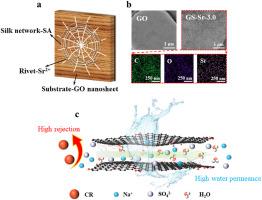"结构稳定的氧化石墨烯膜 "网络陷阱工程
IF 9
1区 工程技术
Q1 ENGINEERING, CHEMICAL
引用次数: 0
摘要
氧化石墨烯(GO)膜因其独特的二维结构和优异的筛分性能,被认为是高效水处理的理想候选材料。然而,氧化石墨烯在水溶液中的膨胀性使其在实际应用中仍面临挑战。受蜘蛛网的启发,在这项工作中,我们开发了一种 "网络陷阱工程 "策略来稳定 GO 膜的层间间距,并将其定义为 GS-Sr 膜。海藻酸钠(SA)和 Sr2+ 分别作为 "网络 "和 "铆钉 "被成功固定在 GO 纳米片之间。得益于网络结构的设计,GS-Sr 膜表现出优异的层间间距稳定性。同时,GO 薄片中这种均匀分布的网络结构可以进一步优化纳米片的堆叠,形成更有序的二维封闭纳米通道。因此,这种膜具有优异的盐分/染料筛分性能,Na2SO4/CR 的分离因子高达 179.13,同时还能保持 70.14 L m-2 h-1 bar-1 的出色透水性。此外,GS-Sr 膜在长期测试中表现出稳定的分离性能,在机械测试中的机械稳定性也有所提高。总之,与传统的简单交联策略相比,这种策略为二维纳米通道的精细构建提供了新的视角。本文章由计算机程序翻译,如有差异,请以英文原文为准。

“Network-trapped engineering” of graphene oxide membrane with stable structure
Graphene oxide (GO) membranes are considered ideal candidates for efficient water treatment due to their unique two-dimensional structure and excellent sieving properties. However, the swelling of graphene oxide in aqueous solutions makes it still challenging for practical application. Inspired by the spider web, in this work, we developed a “network-trapped engineering” strategy to stabilize the interlayer spacings of GO membranes, which are defined as GS-Sr membranes. The sodium alginate (SA) and Sr2+ were successfully fixed as the “network” and “rivets” in-between the GO nanosheets, respectively. Benefiting from the design of the network structure, the GS-Sr membranes exhibited excellent interlayer spacing stability. Meanwhile, this evenly distributed network structure in the GO laminates can further optimize the stacking of nanosheets, forming more orderly 2D confined nanochannels. As a result, the membranes exhibited superior salt/dye sieving performance, with a separation factor up to 179.13 for Na2SO4/CR, while still maintaining an outstanding water permeance of 70.14 L m−2 h−1 bar−1. Furthermore, the GS-Sr membrane demonstrated stable separation performance in the long-term test, and the mechanical stability has also been enhanced in the mechanical test. Overall, compared with traditional simple cross-linking strategies, this strategy offers a new insight into fine-construction of two-dimensional nanochannels.
求助全文
通过发布文献求助,成功后即可免费获取论文全文。
去求助
来源期刊

Journal of Membrane Science
工程技术-高分子科学
CiteScore
17.10
自引率
17.90%
发文量
1031
审稿时长
2.5 months
期刊介绍:
The Journal of Membrane Science is a publication that focuses on membrane systems and is aimed at academic and industrial chemists, chemical engineers, materials scientists, and membranologists. It publishes original research and reviews on various aspects of membrane transport, membrane formation/structure, fouling, module/process design, and processes/applications. The journal primarily focuses on the structure, function, and performance of non-biological membranes but also includes papers that relate to biological membranes. The Journal of Membrane Science publishes Full Text Papers, State-of-the-Art Reviews, Letters to the Editor, and Perspectives.
 求助内容:
求助内容: 应助结果提醒方式:
应助结果提醒方式:


